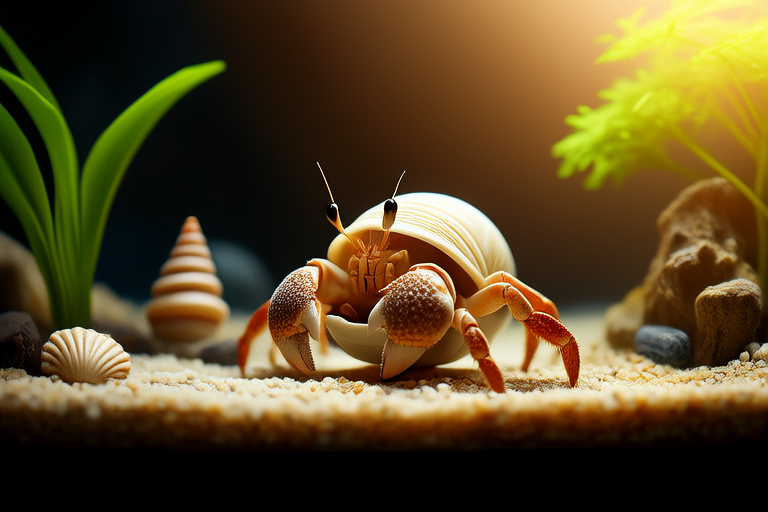The Ultimate Guide to Creating a Happy Home for Your Hermit Crab
Hermit crabs are fascinating, low-maintenance pets that bring joy and curiosity into any home. However, creating the perfect environment for these quirky creatures requires some knowledge and effort. Whether you’re a beginner or an experienced crab owner, this guide will walk you through everything you need to know to ensure your hermit crab thrives in captivity.
Selecting the Right Tank
A proper tank is the foundation of a happy home for your hermit crab. These animals need space to roam, climb, and explore. A 10-gallon tank is the minimum size for one or two small hermit crabs, but if you have more crabs or larger ones, consider upgrading to a 20-gallon or bigger tank.
Tips:
- Choose a glass or plastic tank with a secure lid to prevent escapes.
- Avoid wire mesh lids, as they can cause humidity to escape too quickly.
- Ensure the tank has enough ventilation to maintain air quality without drying out the habitat.
Common Mistake: Using a tank that’s too small. Cramped quarters can lead to stress and health issues.
Proper Substrate Choices
The substrate is where your hermit crab will burrow during molting—a critical phase of their life cycle. Sand is the most popular choice because it mimics their natural environment and allows them to dig comfortably.
Options:
- Fine-grade play sand (available at hardware stores).
- Coconut fiber (often sold as “Eco Earth”) mixed with sand for added moisture retention.
Tips:
- Layer the substrate at least three times the height of your largest crab to allow deep burrowing.
- Avoid gravel, wood chips, or cedar shavings, as they can be harmful or uncomfortable for your crab.
Common Mistake: Not providing enough depth for burrowing, which can disrupt molting.
Maintaining Ideal Temperature and Humidity Levels
Hermit crabs thrive in warm, humid environments that replicate their tropical origins. Maintaining the right conditions is essential for their health and happiness.
Ideal Conditions:
- Temperature: 75-85°F (24-29°C).
- Humidity: 70-80%.
Tips:
- Use an under-tank heater or heat lamp to regulate temperature.
- Place a hygrometer and thermometer in the tank to monitor levels consistently.
- Mist the tank daily with dechlorinated water to boost humidity.
Common Mistake: Allowing temperatures to drop below 70°F, which can cause lethargy and even death.
Providing Fresh Water and Saltwater Sources
Hermit crabs require access to both fresh and saltwater to stay hydrated and maintain their exoskeletons. Always use dechlorinated water, as chlorine is toxic to them.
Tips:
- Set up two shallow dishes—one for freshwater and one for saltwater.
- Mix marine-grade aquarium salt with dechlorinated water to create the saltwater solution.
- Ensure the dishes are shallow enough for your crabs to climb in and out easily.
Common Mistake: Using table salt instead of marine-grade salt, which lacks essential minerals.
Offering a Balanced Diet
Hermit crabs are omnivores and enjoy a varied diet. Feeding them a mix of proteins, fruits, vegetables, and calcium-rich foods ensures they get all the nutrients they need.
Food Ideas:
- Fruits like apples, bananas, and mangoes.
- Vegetables such as carrots, spinach, and zucchini.
- Proteins like boiled eggs, fish flakes, or mealworms.
- Calcium sources like cuttlebones or crushed eggshells.
Tips:
- Remove uneaten food within 24 hours to prevent mold growth.
- Offer a variety of foods to keep meals exciting and nutritious.
Common Mistake: Feeding only commercial pellets, which may lack diversity and essential nutrients.
Choosing Safe Decorations and Climbing Structures
Hermit crabs love to climb and explore. Adding safe decorations and structures not only enhances their environment but also encourages natural behaviors.
Safe Options:
- Driftwood, rocks, and ceramic pots.
- PVC pipes or tunnels for hiding spots.
- Plastic plants (ensure they’re non-toxic and free of sharp edges).
Tips:
- Secure heavy items to prevent tipping.
- Avoid painted or treated materials, as they could be toxic.
Common Mistake: Including decorations with small parts that can trap or injure your crabs.
Understanding Molting Behavior
Molting is a natural process where hermit crabs shed their exoskeleton to grow. During this time, they become vulnerable and retreat into solitude.
Signs of Molting:
- Digging behavior.
- Reduced activity and appetite.
- A pale or ashy appearance.
Tips:
- Do not disturb a molting crab; leave them alone until they emerge on their own.
- Provide plenty of substrate for digging and hiding.
- Avoid handling your crab during this sensitive period.
Common Mistake: Disturbing a molting crab, which can cause stress and harm.
Promoting Social Interaction with Other Hermit Crabs
Hermit crabs are social animals and often do better when kept in groups. Having companions can reduce stress and encourage natural behaviors.
Tips:
- Keep at least two or more crabs together, depending on tank size.
- Introduce new crabs gradually to avoid territorial disputes.
- Monitor interactions to ensure no bullying occurs.
Common Mistake: Keeping a single hermit crab in isolation, which can lead to loneliness and stress.
Final Thoughts
Creating a happy home for your hermit crab involves careful planning and attention to detail. By selecting the right tank, maintaining ideal conditions, and providing enrichment, you’ll give your pet the best chance to thrive. Remember, patience and observation are key—watch how your crabs behave and adjust their environment accordingly.
With this ultimate guide, you’re well-equipped to provide a loving and stimulating habitat for your hermit crab. Enjoy the journey of caring for these unique and captivating creatures!
